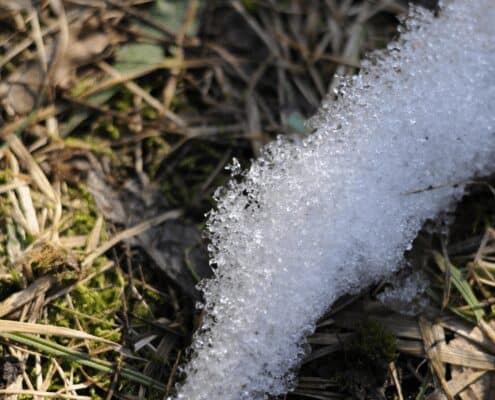
Getting the Garden Ready for Spring
As the snow melts away, it’s time to start thinking about getting back into the garden and preparing it for the upcoming growing season. However, before you start working in the garden, it’s important to keep in mind that insects have been hibernating through the winter and may still be sleeping. To protect these vulnerable bugs, it’s essential to prioritize certain tasks before others to minimize any disturbance.
In this post, we’ll discuss some of the essential tasks to prioritize when getting back into the garden after the snow melts. By following these tips, you can ensure that your garden is ready for the upcoming growing season while also protecting the insects that call it home. So, let’s get started!
Wait to Rake:
- Many gardeners are eager to start raking up leaves and debris as soon as the snow melts. However, waiting a few weeks before raking is important to give insects like bees a chance to emerge from their winter hiding spots. Bees often spend the winter in leaf litter and garden debris, and raking too early can disrupt their habitats and potentially harm them.
- When temperatures are consistently above 10°C, and the ground has had a chance to dry, gently rake the lawn to remove thatch and any remaining dead leaves.
Clean Up Carefully:
- When it is finally time to clean up the debris, do so carefully. Be sure to check for any hibernating insects and relocate them to a safe spot away from any disturbances. Leave some areas of debris in the garden for the insects to use as shelter and nesting sites, at least until temperatures warm and insects emerge.
- Clear mulch from perennials and press the soil back in place that was heaved by frost.
- Remove burlap and protective coverings, but keep at the ready for quick changes in weather.
- Collect fallen branches, twigs and other debris from your yard and gardens. Be careful not to disturb new growth when in the garden.
Prune with Care:
- If you need to prune your plants, do so with care. Prune only what is necessary and avoid cutting back too much. This will help preserve any overwintering insects that may be hiding in the branches or under the bark.
- Cut back dead stems of perennials and prune fruit trees, being careful not to prune any spring-blooming shrubs.
- Summer flowering shrubs should be pruned in early spring before growth begins, then pruned again to remove spent flowers. These include roses, pink spireas, Potentilla, butterfly bush, Blue Mist shrubs and *some* hydrangeas.
Prepare the Soil:
- Work in a top layer of fresh compost into your gardens to help prepare beds for annuals, new perennials and edibles you want to plant.
Check for Damaged Areas:
- Check for any areas of the garden that may have been damaged over the winter. This can include levelling garden stones, cracked pots, broken branches or damaged soil. Repair any damage as soon as possible to ensure that the garden is ready for the growing season.
Take Inventory
- Organize your gardening supplies, take note of what you have and make a list of what you need to buy.
- Sharpen or repair tools, such as pruners and lawnmower blades.
The safe time to get back into the garden without disturbing insects depends on the specific insects in your region and their life cycle. However, as a general guideline, it’s best to wait until temperatures have warmed up and the soil has had a chance to dry out before working in the garden.
Insects have different hibernation patterns, and some may emerge earlier than others. For example, honeybees may start flying when the temperature is above 10°C (50°F), while bumblebees may wait until temperatures reach around 15°C (60°F). Ladybugs and butterflies may also emerge early in the season.
Generally, waiting until temperatures are consistently above freezing and the soil has dried out before working in the garden is best. This will ensure that you don’t accidentally disturb any insects that may still be in hibernation or emerging from their winter habitats.
By taking these steps, you can help create a welcoming environment for bees and other pollinators as they emerge from hibernation. The garden will also be ready for the growing season, ensuring that your plants thrive throughout spring and summer.
– Happy Gardening!
